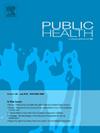The trend in pancreatic cancer incidence from 2009 to 2019 and the prediction from 2020 to 2030: An analysis of provincial data in China
IF 3.9
3区 医学
Q1 PUBLIC, ENVIRONMENTAL & OCCUPATIONAL HEALTH
引用次数: 0
Abstract
Objective
As a malignant tumour with a very high mortality rate, the incidence of pancreatic cancer is on the rise globally, but the long-term trend at the provincial level in China is not yet clear. This study aimed to investigate the trend of pancreatic cancer incidence in Jiangsu Province from 2009 to 2019 and to predict pancreatic cancer incidence from 2020 to 2030.
Study design
Descriptive study.
Methods
Data on pancreatic cancer incidence in Jiangsu Province were obtained from the Jiangsu Cancer Registry. Trends in pancreatic cancer incidence from 2009 to 2019 were examined based on the Joinpoint regression model. Age-period-cohort (APC) models were introduced to estimate the independent effects of age, period, and cohort on the incidence of pancreatic cancer and to project pancreatic cancer incidence from 2020 to 2030.
Results
From 2009 to 2019, the number of pancreatic cancer cases in Jiangsu Province increased from 1146 to 2088, and the age-standardized incidence rate (ASIR) increased from 4.59 to 5.64 per 100,000 people. In 2019, the ASIR was higher in males than in females, and the ASIR was higher in urban areas than in rural areas. The APC analysis also showed that the age effect was the most important factor influencing pancreatic cancer incidence in Jiangsu Province. Predictions suggest that pancreatic cancer incidence will continue to increase from 2020 to 2030.
Conclusions
From 2009 to 2019, the pancreatic cancer incidence in Jiangsu Province showed an increasing trend. The incidence rate is higher among males and urban residents. It is expected that the incidence of pancreatic cancer will continue to increase in the next decade. Therefore, pancreatic cancer prevention and control efforts should continue to focus on older adults and males. This study develops an advanced provincial prediction model, which provides a quantitative basis for allocating screening resources to high-risk populations and provides a reference paradigm for cancer prevention and control strategies in other developing countries undergoing industrialization.
2009-2019年胰腺癌发病趋势及2020-2030年预测:中国省级数据分析
目的胰腺癌作为一种死亡率极高的恶性肿瘤,在全球范围内发病率呈上升趋势,但在中国各省的长期趋势尚不明确。本研究旨在了解江苏省2009 - 2019年胰腺癌发病趋势,预测2020 - 2030年胰腺癌发病情况。研究设计:描述性研究。方法江苏省胰腺癌发病率资料来源于江苏省肿瘤登记处。基于Joinpoint回归模型研究2009 - 2019年胰腺癌发病率趋势。引入年龄-时期-队列(APC)模型来估计年龄、时期和队列对胰腺癌发病率的独立影响,并预测2020年至2030年的胰腺癌发病率。结果2009 - 2019年,江苏省胰腺癌病例数从1146例增加到2088例,年龄标准化发病率(ASIR)从每10万人4.59例增加到5.64例。2019年,男性ASIR高于女性,城市地区ASIR高于农村地区。APC分析还显示,年龄效应是影响江苏省胰腺癌发病率的最重要因素。预测显示,从2020年到2030年,胰腺癌的发病率将继续增加。结论2009 - 2019年,江苏省胰腺癌发病率呈上升趋势。男性和城市居民的发病率较高。预计未来十年胰腺癌的发病率将继续上升。因此,胰腺癌的预防和控制工作应继续集中在老年人和男性身上。本研究建立了先进的省级预测模型,为高危人群的筛查资源配置提供了定量依据,并为其他工业化发展中国家的癌症防治策略提供了参考范式。
本文章由计算机程序翻译,如有差异,请以英文原文为准。
求助全文
约1分钟内获得全文
求助全文
来源期刊

Public Health
医学-公共卫生、环境卫生与职业卫生
CiteScore
7.60
自引率
0.00%
发文量
280
审稿时长
37 days
期刊介绍:
Public Health is an international, multidisciplinary peer-reviewed journal. It publishes original papers, reviews and short reports on all aspects of the science, philosophy, and practice of public health.
 求助内容:
求助内容: 应助结果提醒方式:
应助结果提醒方式:


